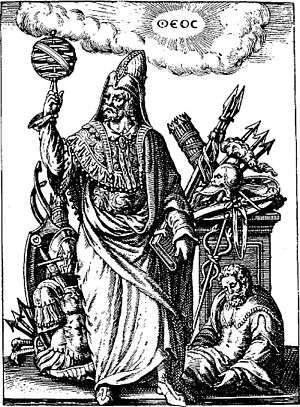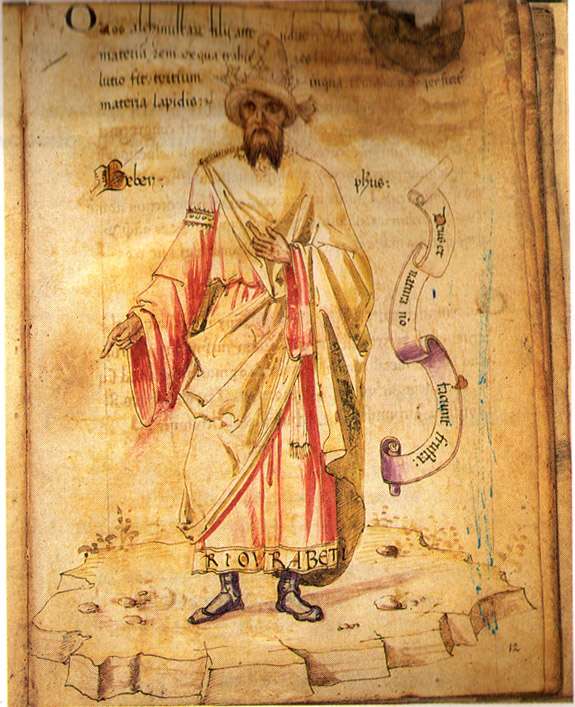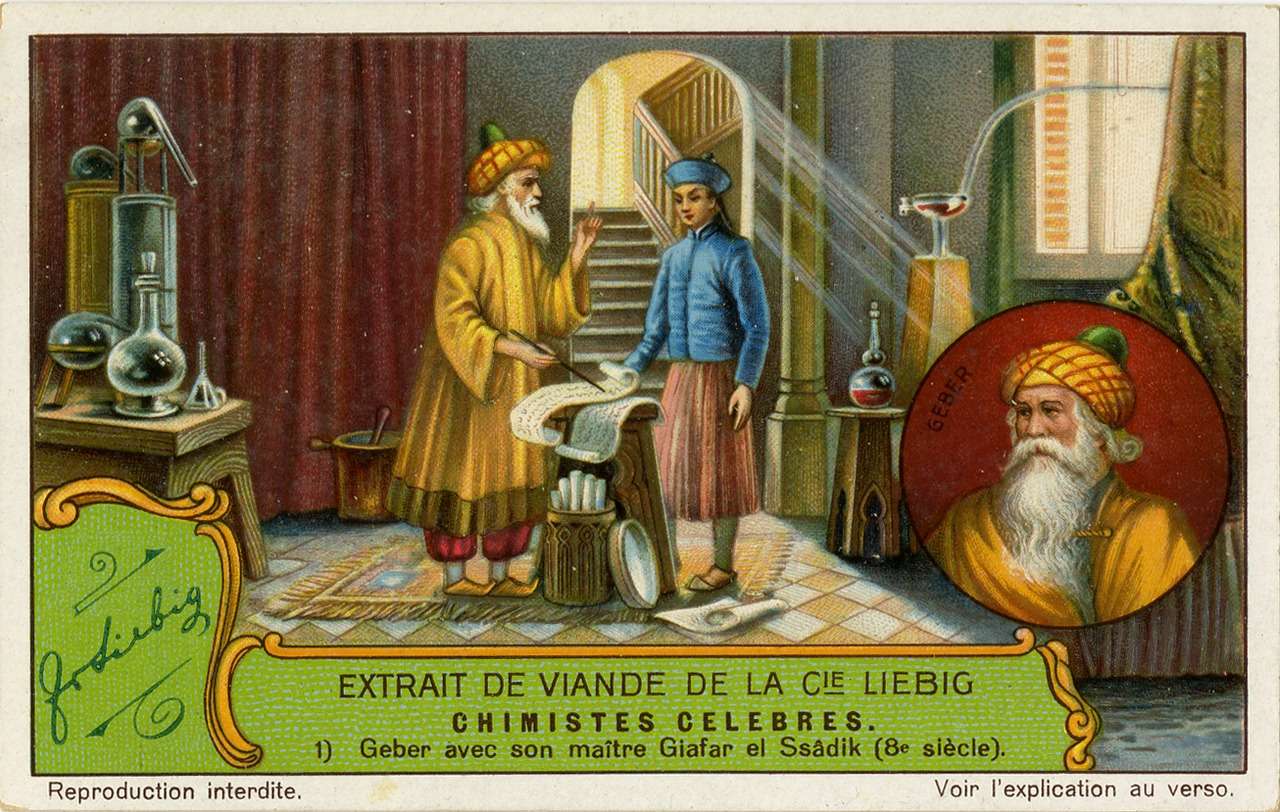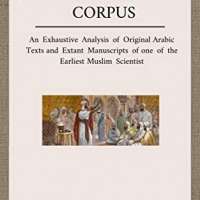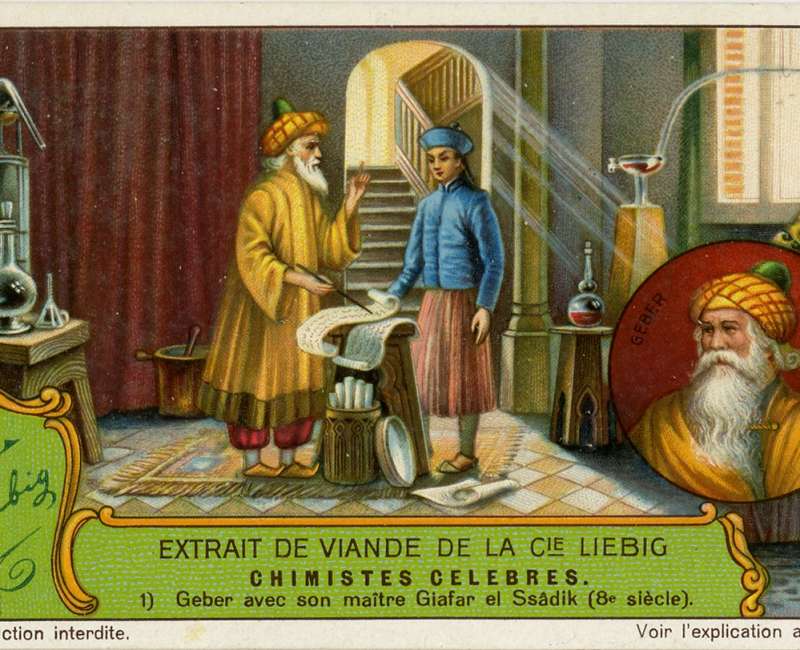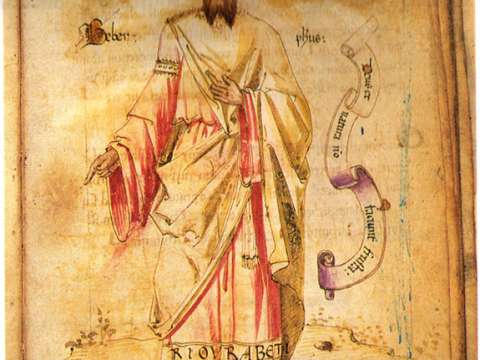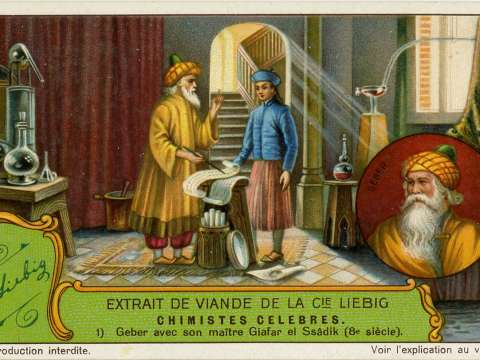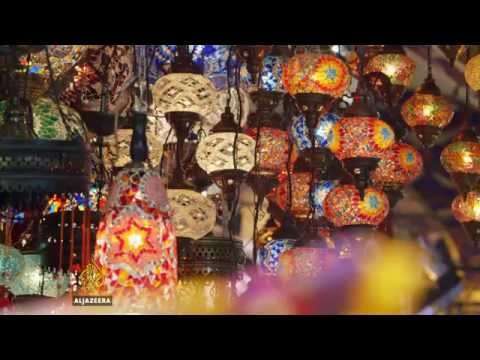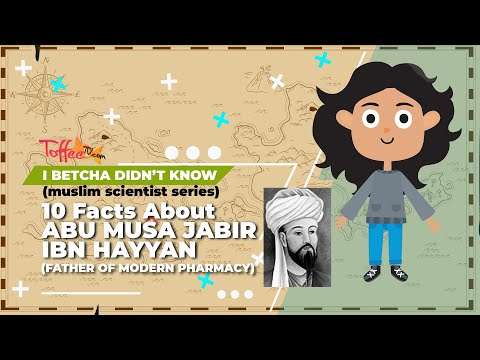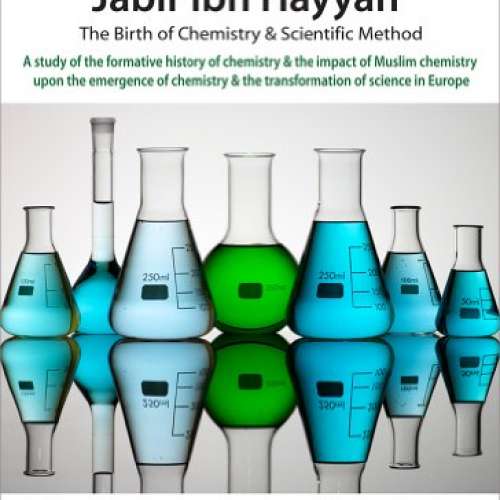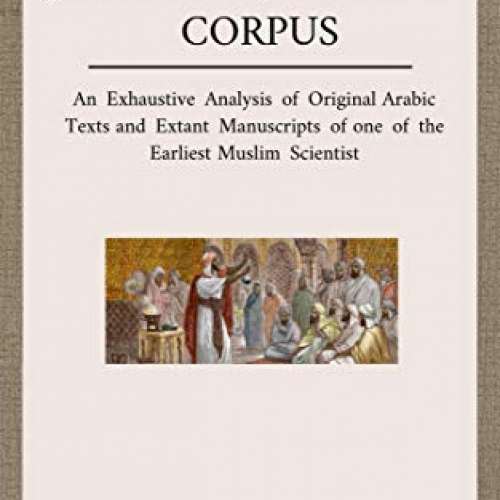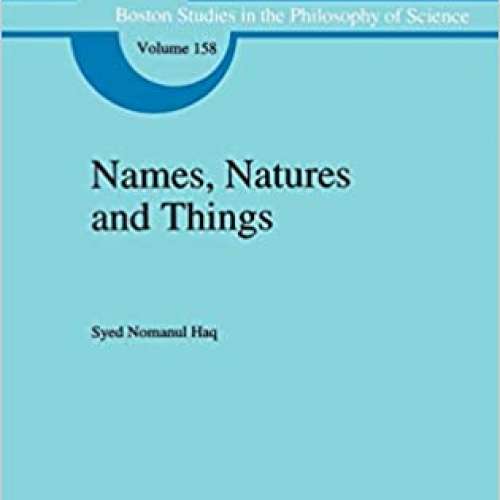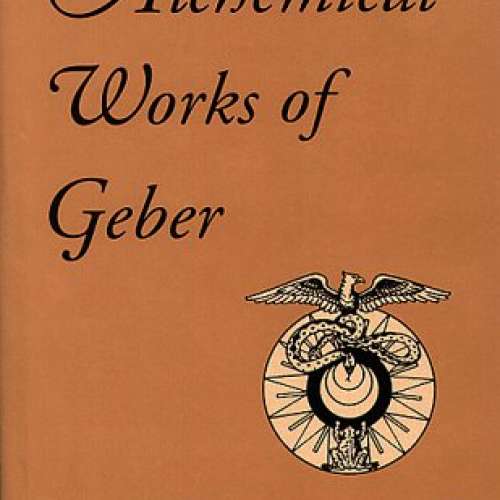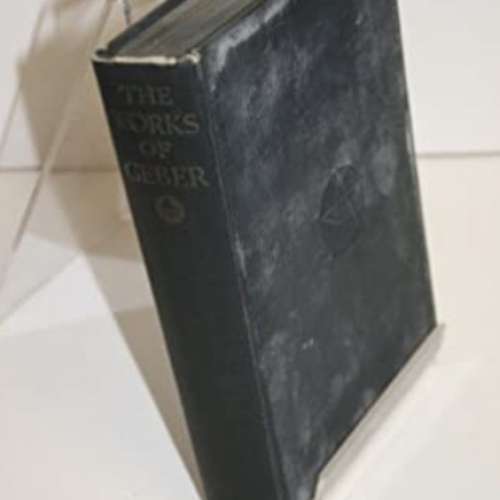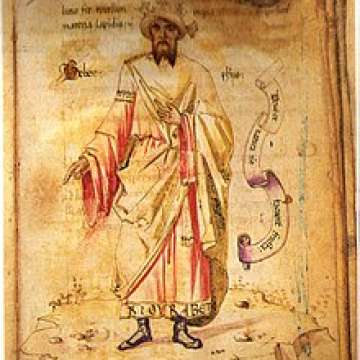

Abu Musa Jabir ibn Hayyan (0721-0813)
The first essential in chemistry is that you should perform practical work and conduct experiments, for he who performs not practical work nor makes experiments will never attain to the least degree of mastery. But you, O my son, do experiment's so that you may acquire knowledge. Scientists delight not in abundance of material; they rejoice only in the excellence of their experimental methods.
Abu Musa Jabir ibn Hayyan (Also known as al-Azdi, al-Kufi, al-Tusi or al-Sufi), is the supposed author of an enormous number and variety of works in Arabic often called the Jabirian corpus. The scope of the corpus is vast and diverse covering a wide range of topics, including alchemy, cosmology, numerology, astrology, medicine, magic, mysticism and philosophy.
Popularly known as the father of chemistry, Jabir's works contain the oldest known systematic classification of chemical substances, and the oldest known instructions for deriving an inorganic compound (sal ammoniac or ammonium chloride) from organic substances (such as plants, blood, and hair) by chemical means.
As early as the 10th century, the identity and exact corpus of works of Jabir was in dispute in Islamic circles. The authorship of all these works by a single figure, and even the existence of a historical Jabir, are also doubted by modern scholars. Instead, Jabir ibn Hayyan is seen more like a pseudonym to whom "underground writings" by various authors became ascribed.

Some Arabic Jabirian works (e.g., the "Book of Mercy", and the "Book of Seventy") were translated into Latin under the Latinized name "Geber", and in 13th-century Europe an anonymous writer, usually referred to as pseudo-Geber, started to produce alchemical and metallurgical writings under this name.
In 988 Ibn al-Nadim compiled the Kitab al-Fihrist which mentions Jabir as a spiritual follower, companion and as a student to Jafar as-Sadiq, the sixth Shia Imam. In another reference al-Nadim reports that a group of philosophers claimed Jabir was one of their own members. Another group, reported by al-Nadim, says only The Large Book of Mercy is genuine and that the rest are pseudographical. Their assertions are rejected by al-Nadim. Joining al-Nadim in asserting a real Jabir; Ibn-Wahshiyya ("Jaber ibn Hayyn al-Sufi ...book on poison is a great work...") Rejecting a real Jabir; (the philosopher c. 970) Abu Sulayman al-Sijistani claims the real author is one al-Hasan ibn al-Nakad al-Mawili. The 14th century critic of Arabic literature, Jamal al-Din ibn Nubata al-Misri declares all the writings attributed to Jabir doubtful.
Life and background
According to the philologist-historian Paul Kraus (1904–1944), Jabir cleverly mixed in his alchemical writings unambiguous references to the Ismaili or Qarmati movement. Kraus wrote: "Let us first notice that most of the names we find in this list have undeniable affinities with the doctrine of Shi'i Gnosis, especially with the Ismaili system." Henry Corbin believes that Jabir ibn Hayyan was an Ismaili. Jabir was a natural philosopher who lived mostly in the 8th century; he was born in Tus, Khorasan, in Persia, then ruled by the Umayyad Caliphate. Jabir in the classical sources has been variously attributed as al-Azdi, al-Kufi, al-Tusi, al-Sufi, al-Tartusi or al-Tarsusi, and al-Harrani. There is a difference of opinion as to whether he was an Arab from Kufa who lived in Khurasan, or a Persian from Khorasan who later went to Kufa or whether he was, as some have suggested, of Syrian Sabian origin and later lived in Persia and Iraq. In some sources, he is reported to have been the son of Hayyan al-Azdi, a pharmacist of the Arabian Azd tribe who emigrated from Yemen to Kufa (in present-day Iraq). while Henry Corbin believes Geber seems to have been a non-Arab client of the 'Azd tribe. Hayyan had supported the Abbasid revolt against the Umayyads, and was sent by them to the province of Khorasan to gather support for their cause. He was eventually caught by the Umayyads and executed. His family fled to Yemen, perhaps to some of their relatives in the Azd tribe, where Jabir grew up and studied the Quran, mathematics and other subjects. Jabir's father's profession may have contributed greatly to his interest in alchemy.
After the Abbasids took power, Jabir went back to Kufa. He began his career practicing medicine, under the patronage of a Vizir (from the noble Persian family Barmakids) of Caliph Harun al-Rashid. His connections to the Barmakid cost him dearly in the end. When that family fell from grace in 803, Jabir was placed under house arrest in Kufa, where he remained until his death.

It has been asserted that Jabir was a student of the sixth Imam Ja'far al-Sadiq and Harbi al-Himyari; however, other scholars have questioned this theory.
The Jabirian corpus
In total, nearly 3,000 treatises and articles are credited to Jabir ibn Hayyan. Following the pioneering work of Paul Kraus, who demonstrated that a corpus of some several hundred works ascribed to Jābir were probably a medley from different hands,:3 mostly dating to the late 9th and early 10th centuries, many scholars believe that many of these works consist of commentaries and additions by his followers,[citation needed] particularly of an Ismaili persuasion. On the other hand, contemporary scholar Syed Nomanul Haq refuses the multiplicity of authors hypothesis, and says that Kraus has misrepresented the Jabirian corpus for three main reasons : a) he hasn't inspected the bibliographies correctly, considering that there have been many leaps (in one instance, we have no titles between 500 and 530), so, all in all, the numbers are more over 500 than close to 3000 ; b) in many cases, a part or chapter of a book has been counted as a book itself, like with the Kitab al-Jumal al-'Ishrin (book of twenty maxims), which has been counted for 20 books and c) finally, many of the supposed "books" are not so in the formal sense, the Kitab al-Sahl occupying a single paragraph and many others few folios. Syed Nomanul Haq concludes that "this rough investigation makes it abundantly clear that we should view with a great deal of suspicion any arguments for a plurality of authors which is based on Kraus' inflated estimate of the volume of the Jabirian corpus."
The scope of the corpus is vast: cosmology, music, medicine, magic, biology, chemical technology, geometry, grammar, metaphysics, logic, artificial generation of living beings, along with astrological predictions, and symbolic Imâmî myths.:
- The 112 Books dedicated to the Barmakids, viziers of Caliph Harun al-Rashid. This group includes the Arabic version of the Emerald Tablet, an ancient work that proved a recurring foundation of and source for alchemical operations. In the Middle Ages it was translated into Latin (Tabula Smaragdina) and widely diffused among European alchemists.
- The Seventy Books, most of which were translated into Latin during the Middle Ages. This group includes the Kitab al-Zuhra ("Book of Venus") and the Kitab Al-Ahjar ("Book of Stones").
- The Ten Books on Rectification, containing descriptions of alchemists such as Pythagoras, Socrates, Plato and Aristotle.
- The Books on Balance; this group includes his most famous 'Theory of the balance in Nature'.
Jabir states in his Book of Stones that "The purpose is to baffle and lead into error everyone except those whom God loves and provides for". His works seem to have been deliberately written in highly esoteric code (see steganography), so that only those who had been initiated into his alchemical school could understand them. It is therefore difficult at best for the modern reader to discern which aspects of Jabir's work are to be read as ambiguous symbols, and what is to be taken literally.
People
Jabir professed to have drawn his alchemical inspiration from earlier writers, both legendary and historic, on the subject. In his writings, Jabir pays tribute to Egyptian and Greek alchemists Zosimos, Democritus, Hermes Trismegistus, Agathodaemon, but also Plato, Aristotle, Galen, Pythagoras, and Socrates, as well as the commentators Alexander of Aphrodisias, Simplicius, Porphyry and others.:5

A huge pseudo-epigraphic literature of alchemical books was composed in Arabic, among which the names of Persian authors also appear like Jamasb, Ostanes, Mani, testifying that alchemy-like operations on metals and other substances were also practiced in Persia. The great number of Persian technical names (zaybaq = mercury, nosader = sal-ammoniac) also corroborates the idea of an important Iranian root of medieval alchemy. Ibn al-Nadim reports a dialogue between Aristotle and Ostanes, the Persian alchemist of Achaemenid era, which is in Jabirian corpus under the title of Kitab Musahhaha Aristutalis. Ruska had suggested that the Sasanian medical schools played an important role in the spread of interest in alchemy. He emphasizes the long history of alchemy, "whose origin is Arius ... the first man who applied the first experiment on the [philosopher's] stone... and he declares that man possesses the ability to imitate the workings of Nature" (Nasr, Seyyed Hussein, Science and Civilization of Islam).
Theories
Jabir's alchemical investigations ostensibly revolved around the ultimate goal of takwin, the artificial creation of life. The Book of Assemblage "Kitab Al-Tajmi' " includes several recipes for creating creatures such as scorpions, snakes, and even humans in a laboratory environment, which are subject to the control of their creator. What Jabir meant by these recipes is unknown.
Jabir's alchemical investigations were theoretically grounded in an elaborate numerology related to Pythagorean and Neoplatonic systems.[citation needed] The nature and properties of elements were defined through numeric values assigned to the Arabic consonants present in their name.
By Jabir's time Aristotelian physics had become Neoplatonic. Each Aristotelian element was composed of these qualities: fire was both hot and dry, earth, cold and dry, water cold and moist, and air, hot and moist. This came from the elementary qualities which are theoretical in nature plus substance. In metals two of these qualities were interior and two were exterior. For example, lead was cold and dry and gold was hot and moist. Thus, Jabir theorized, by rearranging the qualities of one metal, a different metal would result. Like Zosimos, Jabir believed this would require a catalyst, an al-iksir, the elusive elixir that would make this transformation possible – which in European alchemy became known as the philosopher's stone.
According to Jabir's mercury-sulfur theory, metals differ from each in so far as they contain different proportions of the sulfur and mercury. These are not the elements that we know by those names, but certain principles to which those elements are the closest approximation in nature. Based on Aristotle's "exhalation" theory the dry and moist exhalations become sulfur and mercury (sometimes called "sophic" or "philosophic" mercury and sulfur). The sulfur-mercury theory is first recorded in a 7th-century work Secret of Creation credited (falsely) to Balinus (Apollonius of Tyana). This view becomes widespread. In the Book of Explanation Jabir says:
The metals are all, in essence, composed of mercury combined and coagulated with sulphur [that has risen to it in earthy, smoke-like vapors]. They differ from one another only because of the difference of their accidental qualities, and this difference is due to the difference of their sulphur, which again is caused by a variation in the soils and in their positions with respect to the heat of the sun
Holmyard says that Jabir proves by experiment that these are not ordinary sulfur and mercury.
The seeds of the modern classification of elements into metals and non-metals could be seen in his chemical nomenclature. He proposed three categories:
- "Spirits" which vaporise on heating, like arsenic (realgar, orpiment), camphor, mercury, sulfur, sal ammoniac, and ammonium chloride.
- "Metals", like gold, silver, lead, tin, copper, iron, and khar-sini (Chinese iron)
- Non-malleable substances, that can be converted into powders, such as stones.
The origins of the idea of chemical equivalents might be traced back to Jabir, in whose time it was recognized that "a certain quantity of acid is necessary in order to neutralize a given amount of base."
Laboratory equipment and material
The Jabirian corpus is renowned for its contributions to alchemy. It shows a clear recognition of the importance of experimentation, "The first essential in chemistry is that thou shouldest perform practical work and conduct experiments, for he who performs not practical work nor makes experiments will never attain to the least degree of mastery." He is credited with the use of over twenty types of now-basic chemical laboratory equipment, such as the alembic and retort, and with the description of many now-commonplace chemical processes – such as crystallisation, various forms of alchemical "distillation", and substances citric acid (the sour component of lemons and other unripe fruits), acetic acid (from vinegar) and tartaric acid (from wine-making residues), arsenic, antimony and bismuth, sulfur, and mercury that have become the foundation of today's chemistry.
According to Ismail al-Faruqi and Lois Lamya al-Faruqi, "In response to Jafar al-Sadiq's wishes, [Jabir ibn Hayyan] invented a kind of paper that resisted fire, and an ink that could be read at night. He invented an additive which, when applied to an iron surface, inhibited rust and when applied to a textile, would make it water repellent."
Directions to make mineral acids such as sulfuric acid, nitric acid and aqua regis appear in the Arabic Jabirian corpus, and later in the pseudo-Geberian works Liber Fornacum, De inventione perfectionis, and the Summa.
According to Forbes, there is no proof that Jabir knew alcohol. Later, Al-Kindi unambiguously described the distillation of wine in the 9th century.
Legacy
Whether Jabir lived in the 8th century or not, his name would become the most famous in alchemy. He paved the way for most of the later alchemists, including al-Kindi, al-Razi, al-Tughrai and al-Iraqi, who lived in the 9th–13th centuries. His books strongly influenced the medieval European alchemists and justified their search for the philosopher's stone. In the Middle Ages, Jabir's treatises on alchemy were translated into Latin and became standard texts for European alchemists. These include the Kitab al-Kimya (titled Book of the Composition of Alchemy in Europe), translated by Robert of Chester (1144); and the Kitab al-Sab'een (Book of Seventy) by Gerard of Cremona (before 1187). Marcelin Berthelot translated some of his books under the fanciful titles Book of the Kingdom, Book of the Balances, and Book of Eastern Mercury. Several technical Arabic terms introduced by Jabir, such as alkali, have found their way into various European languages and have become part of scientific vocabulary.
Max Meyerhoff states of Jabir ibn Hayyan: .
"His influence may be traced throughout the whole historic course of European alchemy and chemistry."
The historian of chemistry Erick John Holmyard gives credit to Jabir for developing alchemy into an experimental science and he writes that Jabir's importance to the history of chemistry is equal to that of Robert Boyle and Antoine Lavoisier. The historian Paul Kraus, who had studied most of Jabir's extant works in Arabic and Latin, summarized the importance of Jabir to the history of chemistry by comparing his experimental and systematic works in chemistry with that of the allegorical and unintelligible works of the ancient Greek alchemists. The word gibberish is theorized to be derived from the Latinised version of Jabir's name, in reference to the incomprehensible technical jargon often used by alchemists, the most famous of whom was Jabir. The Oxford English Dictionary suggests the term stems from gibber; however, the first known use of the term "gibberish" dates prior to the first known use of the word "gibber".
The Geber-Jabir problem
The identity of the author of works attributed to Jabir has long been discussed. According to a famous controversy, pseudo-Geber has been considered as the unknown author of several books in Alchemy. This was first independently suggested, on textual and other grounds, by the 19th-century historians Hermann Kopp and Marcellin Berthelot. Jabir, by reputation the greatest chemist of Islam, has long been familiar to western readers under the name of Geber, which is the medieval rendering of the Arabic Jabir, the Geber of the Middle Ages. The works in Latin corpus were considered to be translations until the studies of Kopp, Hoefer, Berthelot, and Lippman. Although they reflect earlier Arabic alchemy they are not direct translations of "Jabir" but are the work of a 13th-century Latin alchemist. Eric Holmyard says in his book Makers of Chemistry Clarendon press.(1931).
However, by 1957 when he wrote Alchemy Holmyard had abandoned the idea of an Arabic original (although they are based on "Islamic" alchemical theories).
Whatever their origin, they became the principal authorities in early Western alchemy and held that position for two or three centuries.
The question of Pseudo-Gebers identity was still in dispute in 1962. It is said that Geber, the Latinized form of "Jabir," was adopted presumably because of the great reputation of a supposed 8th-century alchemist by the name of Jabir ibn Hayyan. About this historical figure, however, there was considerable uncertainty a century ago, and the uncertainty continues today. This is sometimes called the "Geber-Jābir problem". It is possible that facts mentioned in the Latin works, ascribed to Geber and dating from the twelfth century and later, may be placed to Jabir's credit.
In 2005, the historian Ahmad Y. Al-Hassan pointed out that earlier Arabic texts prior to the 13th century, including the works of Jabir and Al-Razi, already contained detailed descriptions of substances such as nitric acid, aqua regia, vitriol, and various nitrates. In 2009, Al-Hassan criticized Berthelot's original hypothesis and, on textual grounds, argued that the Pseudo-Geber Corpus was originally written in Arabic. Al-Hassan criticized Berthelot's lack of familiarity with the complete Arabic corpus and pointed to various Arabic Jabirian manuscripts which already contain much of the theories and practices that Berthelot previously attributed to the Latin corpus. Regardless of the identity of pseudo-Geber, the contents of the Pseudo-Geber Corpus are mostly derived from earlier Arabic alchemy, including the work of Jabir as well as other Arabic authors such as Al-Razi.
Popular culture
Jabir is mentioned in popular culture works. For example he is mentioned in Paulo Coelho's 1993 bestseller, The Alchemist, in in H. P. Lovecraft's novel The Case of Charles Dexter Ward, In S.H.I.E.L.D, Jabir appears as the 8th century leader of the organization, in The Big Bang Theory, in the episode "The Guitarist Amplification and many others.

